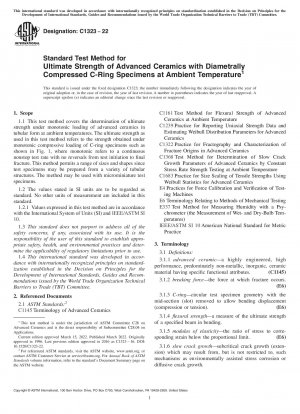ASTM C1323-22
Standard Test Method for Ultimate Strength of Advanced Ceramics with Diametrally Compressed C-Ring Specimens at Ambient Temperature
- Standard No.
- ASTM C1323-22
- Release Date
- 2022
- Published By
- American Society for Testing and Materials (ASTM)
- Latest
- ASTM C1323-22
- Scope
- 1.1 This test method covers the determination of ultimate strength under monotonic loading of advanced ceramics in tubular form at ambient temperatures. The ultimate strength as used in this test method refers to the strength obtained under monotonic compressive loading of C-ring specimens such as shown in Fig. 1, where monotonic refers to a continuous nonstop test rate with no reversals from test initiation to final fracture. This method permits a range of sizes and shapes since test specimens may be prepared from a variety of tubular structures. The method may be used with microminiature test specimens. 1.2 The values stated in SI units are to be regarded as standard. No other units of measurement are included in this standard. 1.2.1 Values expressed in this test method are in accordance with the International System of Units (SI) and IEEE/ASTM SI 10. 1.3 This standard does not purport to address all of the safety concerns, if any, associated with its use. It is the responsibility of the user of this standard to establish appropriate safety, health, and environmental practices and determine the applicability of regulatory limitations prior to use. 1.4 This international standard was developed in accordance with internationally recognized principles on standardization established in the Decision on Principles for the Development of International Standards, Guides and Recommendations issued by the World Trade Organization Technical Barriers to Trade (TBT) Committee.
ASTM C1323-22 Referenced Document
- ASTM C1145 Standard Terminology of Advanced Ceramics
- ASTM C1161 Standard Test Method for Flexural Strength of Advanced Ceramics at Ambient Temperature
- ASTM C1239 Standard Practice for Reporting Uniaxial Strength Data and Estimating Weibull Distribution Parameters for Advanced Ceramics
- ASTM C1322 Standard Practice for Fractography and Characterization of Fracture Origins in Advanced Ceramics
- ASTM C1368 Standard Test Method for Determination of Slow Crack Growth Parameters of Advanced Ceramics by Constant Stress Rate Strength Testing at Ambient Temperature
- ASTM C1683 Standard Practice for Size Scaling of Tensile Strengths Using Weibull Statistics for Advanced Ceramics
- ASTM E337 Standard Test Method for Measuring Humidity with a Psychrometer (the Measurement of Wet- and Dry-Bulb Temperatures)
- ASTM E4 Standard Practices for Force Verification of Testing Machines
- ASTM E6 Standard Terminology Relating to Methods of Mechanical Testing
- IEEE/ASTM SI 10 American National Standard for Metric Practice
ASTM C1323-22 history
- 2022 ASTM C1323-22 Standard Test Method for Ultimate Strength of Advanced Ceramics with Diametrally Compressed C-Ring Specimens at Ambient Temperature
- 2016 ASTM C1323-16 Standard Test Method for Ultimate Strength of Advanced Ceramics with Diametrally Compressed C-Ring Specimens at Ambient Temperature
- 2010 ASTM C1323-10 Standard Test Method for Ultimate Strength of Advanced Ceramics with Diametrally Compressed C-Ring Specimens at Ambient Temperature
- 1996 ASTM C1323-96(2001)e1 Standard Test Method for Ultimate Strength of Advanced Ceramics with Diametrally Compressed C-Ring Specimens at Ambient Temperature
- 1996 ASTM C1323-96(2001) Standard Test Method for Ultimate Strength of Advanced Ceramics with Diametrally Compressed C-Ring Specimens at Ambient Temperature
- 2001 ASTM C1323-96 Standard Test Method for Ultimate Strength of Advanced Ceramics with Diametrally Compressed C-Ring Specimens at Ambient Temperature
